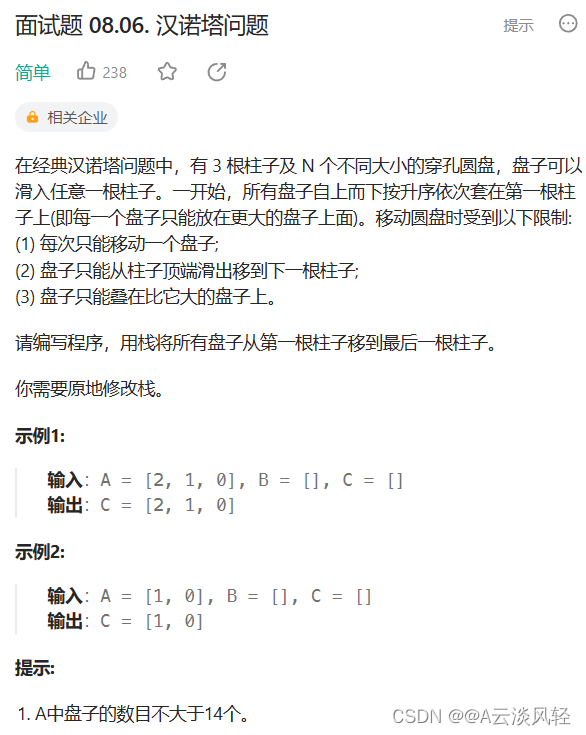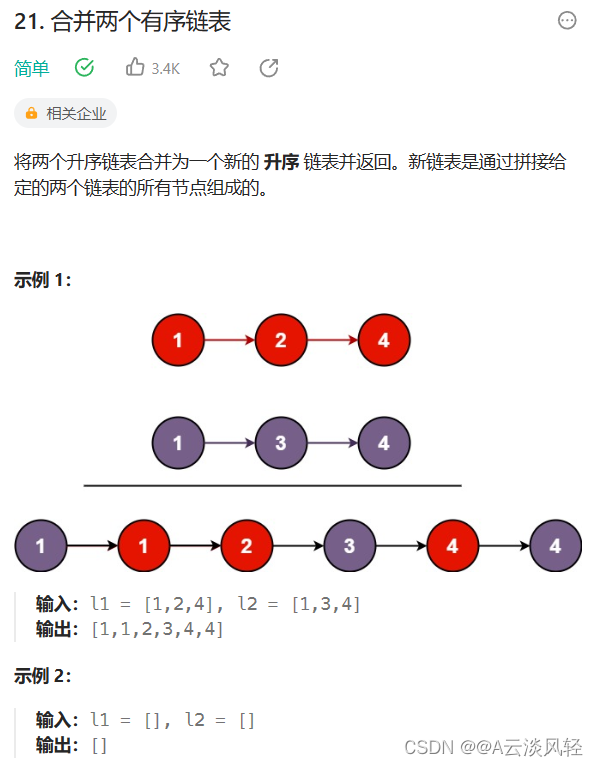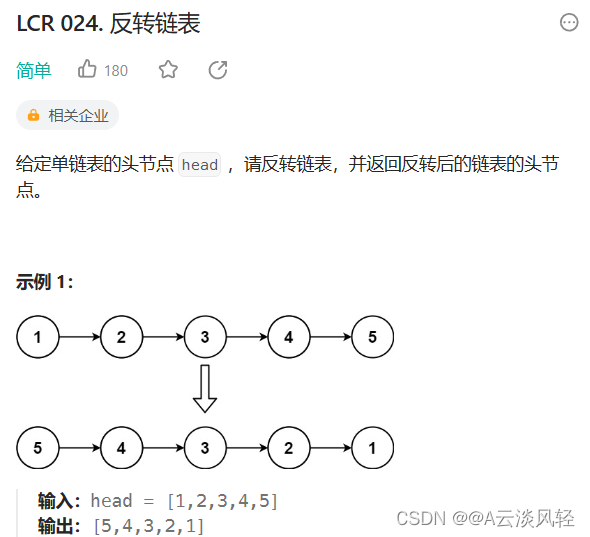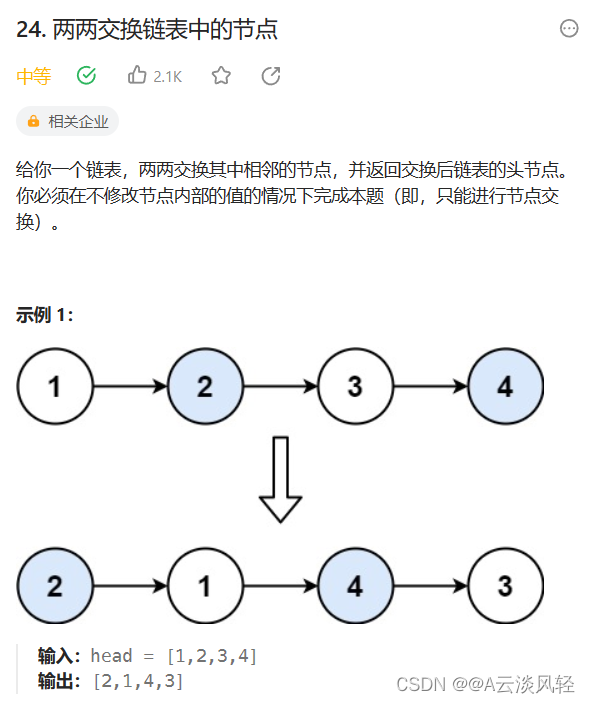leetcode递归算法题总结
2024-01-01 14:12:01
递归本质是找重复的子问题
1.汉诺塔
//面试写法
class Solution {
public:
void hanota(vector<int>& a, vector<int>& b, vector<int>& c) {
dfs(a,b,c,a.size());
}
void dfs(vector<int>& a, vector<int>& b, vector<int>& c,int n)
{
if(n==0) return;
if(n==1)
{
c.push_back(a.back());
a.pop_back();
return;
}
dfs(a,c,b,n-1);
c.push_back(a.back());
a.pop_back();
dfs(b,a,c,n-1);
}
};
//笔试写法
class Solution {
public:
void hanota(vector<int>& A, vector<int>& B, vector<int>& C) {
C =A;
}
};
2.合并两个有序链表
/**
* Definition for singly-linked list.
* struct ListNode {
* int val;
* ListNode *next;
* ListNode() : val(0), next(nullptr) {}
* ListNode(int x) : val(x), next(nullptr) {}
* ListNode(int x, ListNode *next) : val(x), next(next) {}
* };
*/
class Solution {
public:
ListNode* mergeTwoLists(ListNode* list1, ListNode* list2) {
if(list1 == nullptr) return list2;
if(list2 == nullptr) return list1;
if(list1->val<=list2->val)
{
list1->next = mergeTwoLists(list1->next,list2);
return list1;
}
else
{
list2->next = mergeTwoLists(list1,list2->next);
return list2;
}
}
};
3.反转链表
/**
* Definition for singly-linked list.
* struct ListNode {
* int val;
* ListNode *next;
* ListNode() : val(0), next(nullptr) {}
* ListNode(int x) : val(x), next(nullptr) {}
* ListNode(int x, ListNode *next) : val(x), next(next) {}
* };
*/
class Solution {
public:
ListNode* reverseList(ListNode* head) {
if(head == nullptr || head->next == nullptr) return head;
ListNode* newHead = reverseList(head->next);
head->next->next = head;
head->next = nullptr;
return newHead;
}
};
4.两两交换链表中的节点
/**
* Definition for singly-linked list.
* struct ListNode {
* int val;
* ListNode *next;
* ListNode() : val(0), next(nullptr) {}
* ListNode(int x) : val(x), next(nullptr) {}
* ListNode(int x, ListNode *next) : val(x), next(next) {}
* };
*/
class Solution {
public:
ListNode* swapPairs(ListNode* head) {
//递归
if(head == nullptr || head->next == nullptr) return head;
auto tmp = swapPairs(head->next->next);
auto ret = head->next;
head->next->next = head;
head->next = tmp;
return ret;
}
};
class Solution {
public:
//模拟 循环 迭代
ListNode* swapPairs(ListNode* head) {
if(head == nullptr || head->next == nullptr) return head;
ListNode* ret = new ListNode(0);
ListNode* prev = ret;
prev->next = head;
ListNode* cur = prev->next,*next = cur->next,*nnext = next->next;
while(cur && next)
{
//交换节点
prev->next = next;
next->next = cur;
cur->next = nnext;
//更新节点
prev = cur;
cur = nnext;
if(cur) next = cur->next;
if(next) nnext = next->next;
}
cur = ret->next;
delete ret;
return cur;
}
};
5.Pow(x,n)
class Solution {
public:
double myPow(double x, int n) {
//递归+快速幂
return n<0? 1.0/pow(x,-(long long)n):pow(x,n);
}
double pow(double x,long long n)
{
if(n==0) return 1;
double tmp = pow(x,n/2);
return n%2==0? tmp*tmp:tmp*tmp*x;
}
};
文章来源:https://blog.csdn.net/m0_55283616/article/details/135317554
本文来自互联网用户投稿,该文观点仅代表作者本人,不代表本站立场。本站仅提供信息存储空间服务,不拥有所有权,不承担相关法律责任。 如若内容造成侵权/违法违规/事实不符,请联系我的编程经验分享网邮箱:veading@qq.com进行投诉反馈,一经查实,立即删除!
本文来自互联网用户投稿,该文观点仅代表作者本人,不代表本站立场。本站仅提供信息存储空间服务,不拥有所有权,不承担相关法律责任。 如若内容造成侵权/违法违规/事实不符,请联系我的编程经验分享网邮箱:veading@qq.com进行投诉反馈,一经查实,立即删除!




